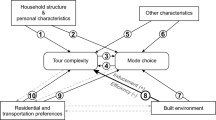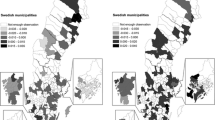Abstract
Some commuters are assumed to include multiple activities in their commutes, e.g. having breakfast, sending children to school or purchasing life necessities, to reduce their costs of travelling. This research attempts to answer two questions: (1) whether the substitution of commuting trip chains for other home-based trips exists; and (2) how the factors effect on the commuting trip chaining propensity. However, trip chaining behaviors would be difficult to empirically study due to the reluctance of respondents to fully report their detailed activity information in traditional travel surveys, especially when the activities are combined in other trips, e.g. commutes. Fortunately, mobile phone sighting data offers an innovative prospect to understand the human activity pattern by fully tracking mobile phone users’ temporal and spatial traces. The study will firstly configure commuters, commuting trajectories and activity sightings from a Shanghai mobile phone sighting dataset; and with the land use, transportation and some socioeconomic data of Shanghai, a panel sample will be derived. Based on this sample, the research will develop two binary response models to find out answers. The main findings are: (1) the substitution of commuting trip chains on other home-based trips is significant; (2) long-distance commuters are more likely to chain their commutes; (3) activity conducting decisions during commuting tend to be based on the built environment near commuters’ workplaces and hardly react to the changes of their residential areas; and (4) the abundance of transport and path choices along commuting corridors improves the possibility of commuting trip chaining. Thus, it can be suggested that some living service facilities should also be distributed along commuting corridors besides near residential areas in public facility planning. And the allocation level of public facility along typical long-distance commuting paths and near main employment centers should be improved.
Access this chapter
Tax calculation will be finalised at checkout
Purchases are for personal use only
Similar content being viewed by others
References
Bayir, M. A., Demirbas, M., & Eagle, N. (2010). Mobility profiler: A framework for discovering mobility profiles of cell phone users. Pervasive and Mobile Computing, 6, 435–454.
Bhat, C. R. (1997). Work travel mode choice and number of non-work commute stops. Transportation Research Part B Methodological, 31(1), 41–54.
Butler, J. S., & Moffitt, R. A. (1982). Computationally efficient quadrature procedure for the one-factor multinomial Probit model. Econometrica, 50(3), 761–764.
Calabrese, F., Diao, M., Lorenzo, G. D., et al. (2013). Understanding individual mobility patterns from urban sensing data: A mobile phone trace example. Transportation Research Part C Emerging Technologies, 26(1), 301–313.
Golob, T. F. (1986). A nonlinear canonical correlation analysis of weekly trip chaining behaviour. Transportation Research Part A General, 20(5), 385–399.
Gonzalez, M., Hidalgo, C., & Barabasi, A.-L. (2008). Understanding individual human mobility patterns. Nature, 453(7196), 779–782.
Hu, S., Cheng, Q., Wang, L., et al. (2013). Modeling land price distribution using multifractal IDW interpolation and fractal filtering method. Landscape & Urban Planning, 110(1), 25–35.
Kim, H., & Kwan, M. (2003). Space-time accessibility measures: A geocomputational algorithm with a focus on the feasible opportunity set and possible activity duration. Journal of Geographical Systems, 5, 71–91.
Mcguckin, N., & Murakami, E. (1999). Examining trip-chaining behavior: Comparison of travel by men and women. Transportation Research Record Journal of the Transportation Research Board, 1693(1).
Mcnally, M. G., Greenwald, M. J., & Mcnally, M. G., et al. (2008). Land-use influences on trip-chaining in Portland, Oregon. Urban Design & Planning, 161d(2), 61–73.
Nishii, K., Kondo, K., & Kitamura, R. (1988). Empirical analysis of trip chaining behavior. Transportation Research Record, 1203, 48–59.
Pendyala, R., Yalamanchili, L., & Prabaharan, N., et al. (1999). Analysis of global positioning systembased data collection methods for capturing multistop trip-Chaining behavior. Transportation Research Record (1).
Phithakkitnukoon, S., Horanont, T., Lorenzo, G. D., Shibasaki, R., & Ratti, C. (2010). Activity-aware map: Identifying human daily activity pattern using mobile phone data. MIT-Senseable City Lab.
Song, C. M., Qu, Z. H., et al. (2010). Limits of predictability in human mobility. Science, 327(5968), 1018–1021.
Song, Y., Merlin, L., & Rodriguez, D. (2013). Comparing measures of urban land use mix. Computers Environment & Urban Systems, 42(7), 1–13.
Wallace, B., Barnes, J., & Rutherford, G. S. (2000). Evaluating the effects of traveler and trip characteristics on trip chaining, with implications for transportation demand management strategies. Transportation Research Record Journal of the Transportation Research Board, 1718(1), 97–106.
Wang, F. (2000). Modeling commuting patterns in Chicago in a GIS environment: A job accessibility perspective. Professional Geographer, 52(1), 120–133.
Wang, A. A. F. (2010). Land use impacts on trip chaining propensity for workers and non-workers in Baton Rouge, Louisiana. Annals of GIS, 16(3), 141–154.
Wang, M. (2014). Understanding activity location choice with mobile phone data. University of Washington.
Xu, Y., Shaw, S. L., & Yin, L., et al. (2012) Understanding individual daily activity space based on large scale mobile phone location data.
Yuan, Y., Raubal, M., & Liu, Y. (2012). Correlating mobile phone usage and travel behavior—A case study of Harbin, China. Computers Environment & Urban Systems, 36(2), 118–130.
Author information
Authors and Affiliations
Editor information
Editors and Affiliations
Rights and permissions
Copyright information
© 2021 Springer Nature Switzerland AG
About this chapter
Cite this chapter
Wang, Y., Pan, H. (2021). Understanding the Substitution of Commuting Trip Chains for Other Home-Based Trips and Factors’ Effects on Commuting Trip Chaining Propensity—Using Shanghai Mobile Phone Sighting Data. In: Li, W., Hu, L., Cao, J. (eds) Human-Centered Urban Planning and Design in China: Volume II. GeoJournal Library, vol 130. Springer, Cham. https://doi.org/10.1007/978-3-030-83860-7_11
Download citation
DOI: https://doi.org/10.1007/978-3-030-83860-7_11
Published:
Publisher Name: Springer, Cham
Print ISBN: 978-3-030-83859-1
Online ISBN: 978-3-030-83860-7
eBook Packages: Social SciencesSocial Sciences (R0)




